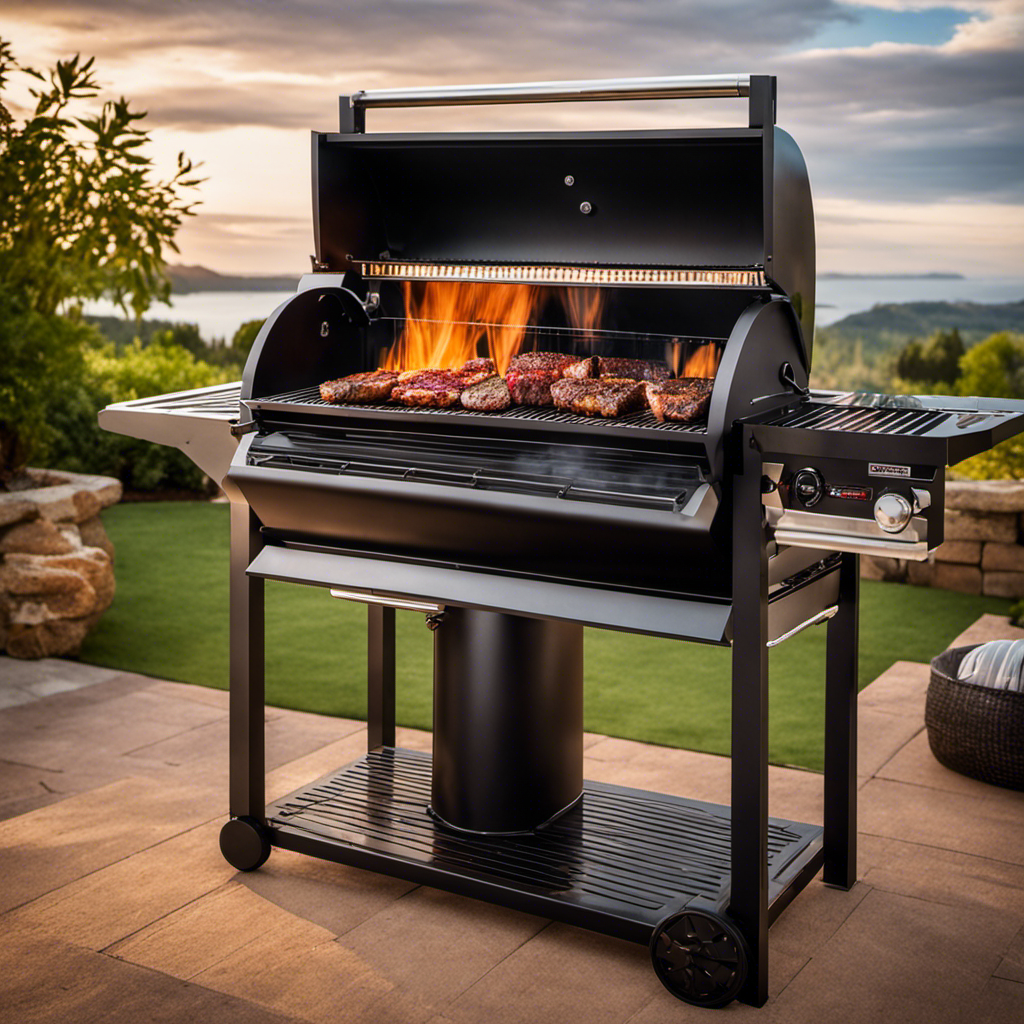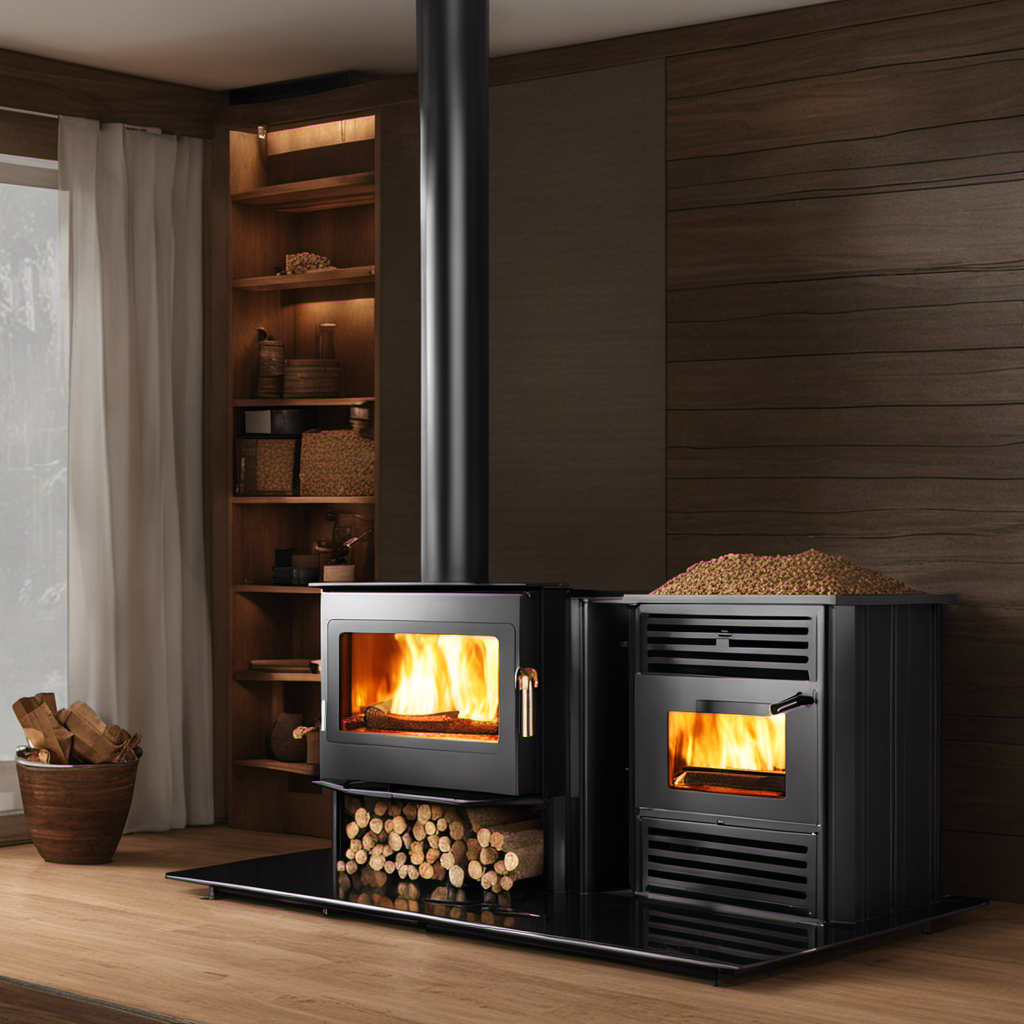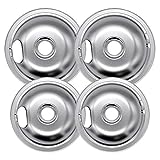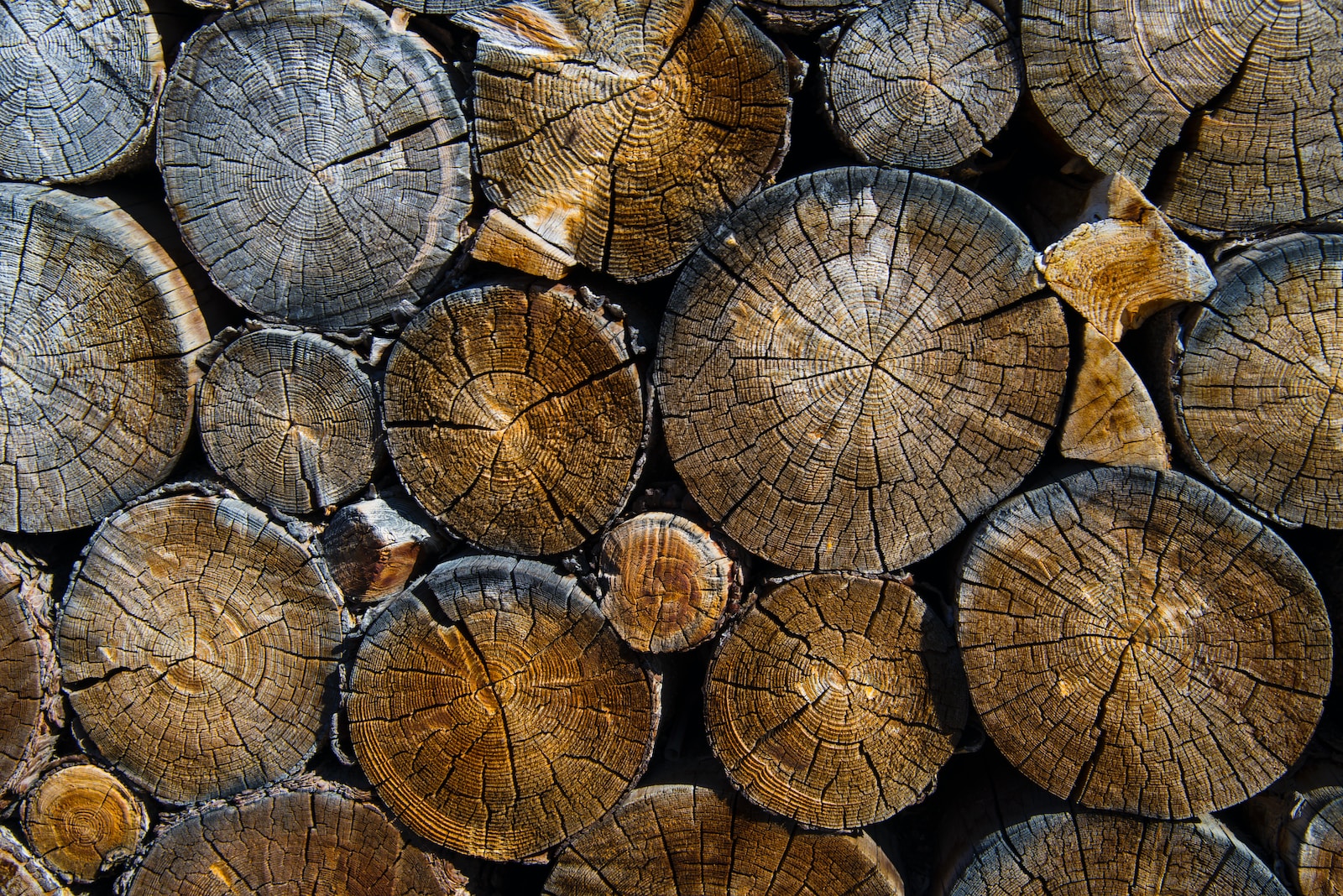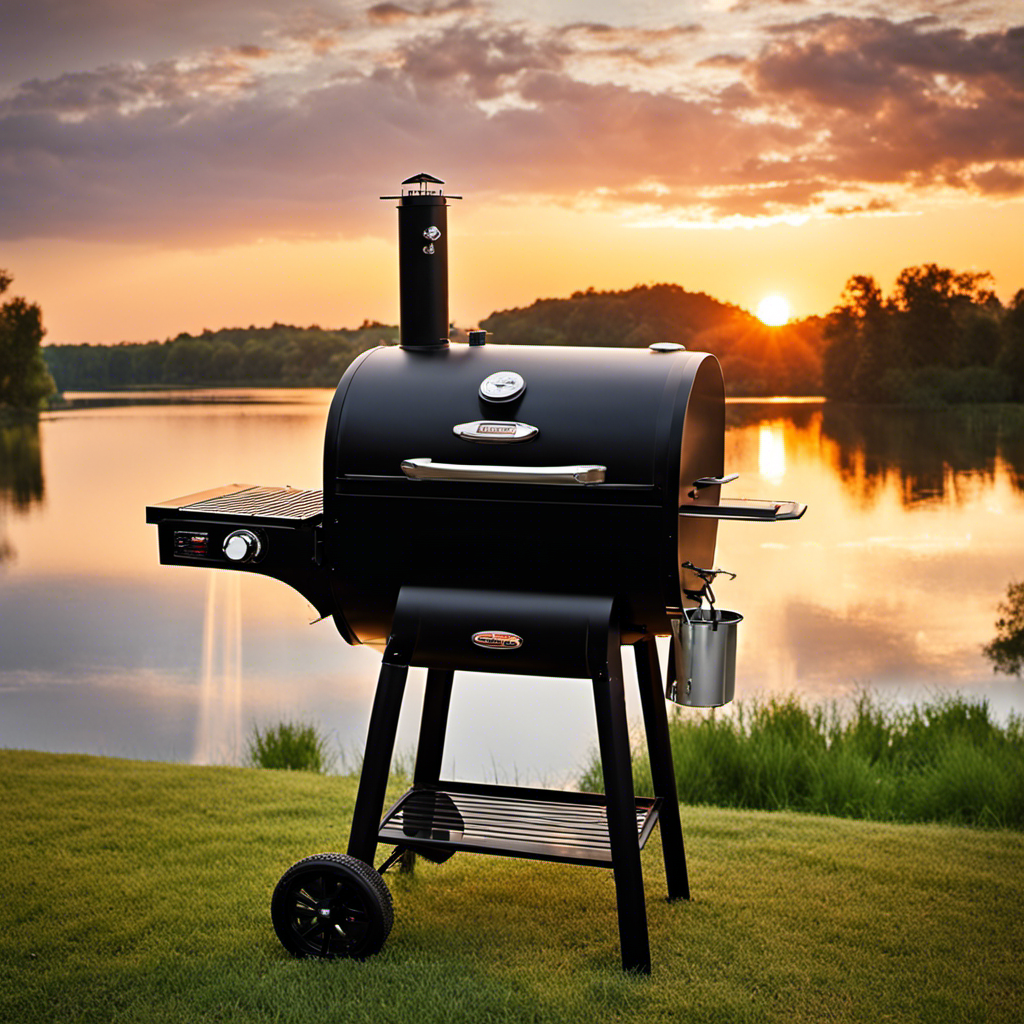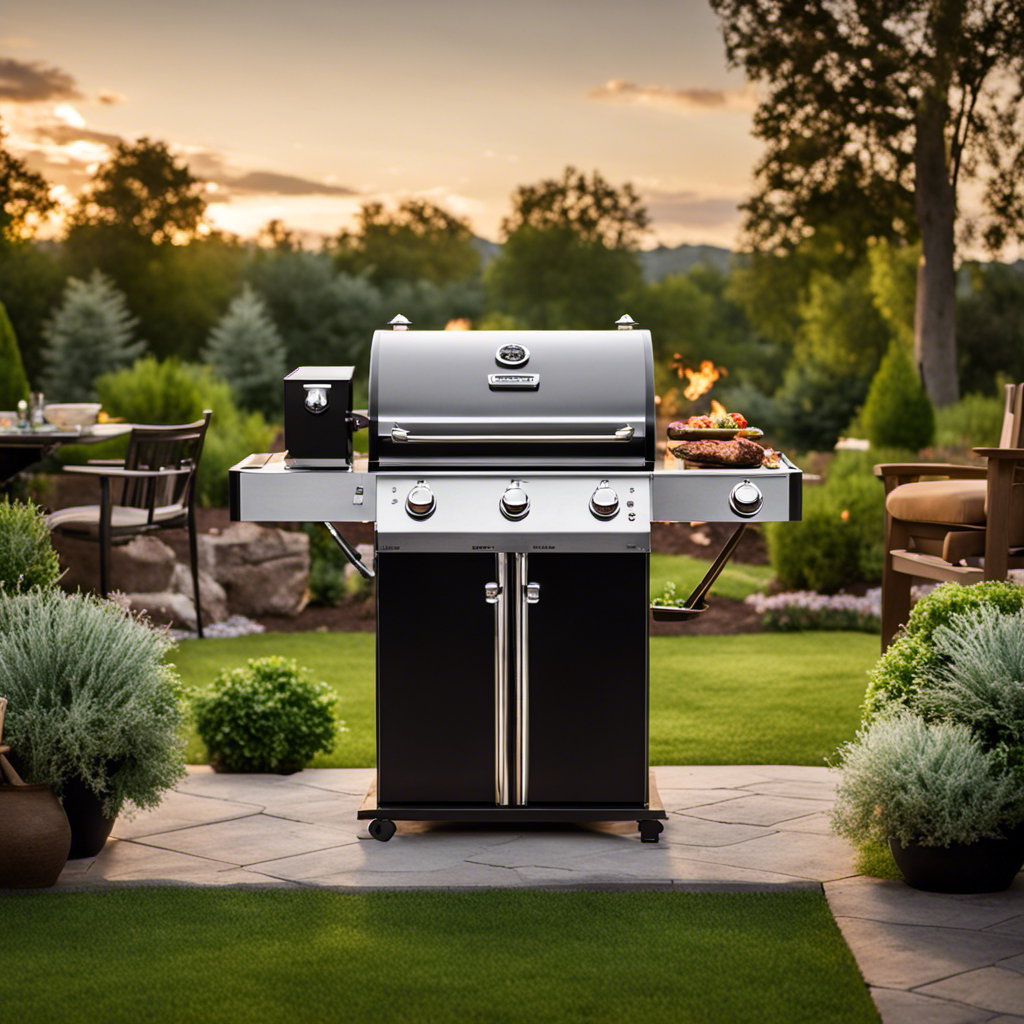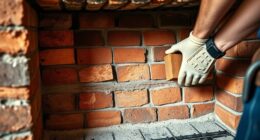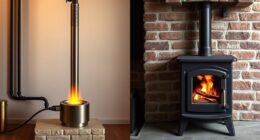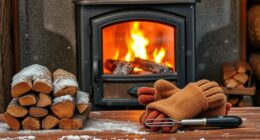Ready to elevate your BBQ game? The wood pellet grill is your solution. With precise temperature control and the ability to infuse meats with a mouthwatering smoky taste, it’s the optimal choice for perfecting your grilling technique.
In this article, I’ll guide you through the process of BBQing on a wood pellet grill, from choosing the right grill to mastering the art of seasoning.
Get ready to impress your friends and family with mouthwatering BBQ that will leave them asking for seconds. Let’s get grilling!
Key Takeaways
- Consider factors such as size, temperature range, and extra features when choosing a wood pellet grill
- Different cuts of meat have unique characteristics and cooking times
- Use vents, a digital thermometer, and preheating to control temperature
- Different meats require different cooking times, techniques, and temperature adjustments
Choosing the Right Wood Pellet Grill
When choosing the right wood pellet grill, you’ll want to consider factors such as size, temperature range, and extra features. As a passionate grilling enthusiast, I can attest to the many benefits of using a wood pellet grill. Not only do they provide incredible flavor, but they also offer versatility and convenience.
There are several reputable wood pellet grill brands on the market, each with their own unique features and advantages. From Traeger to Green Mountain Grills, you can find a grill that suits your needs and preferences. The temperature range of a wood pellet grill allows for precise control, ensuring your food is cooked to perfection every time. Additionally, many models come with extra features like Wi-Fi connectivity and meat probes, further enhancing your grilling experience.
With the right wood pellet grill, you’ll be able to achieve amazing results and impress your friends and family at your next barbecue.
Now let’s move on to preparing your wood pellet grill for BBQ, ensuring you have everything you need for a successful cookout.
Preparing Your Wood Pellet Grill for BBQ
Before you start, make sure to prepare your wood pellet grill for cooking. Proper preparation ensures that your grill is clean and ready to deliver mouthwatering flavors to your food. Here are some essential steps for getting your wood pellet grill ready:
| Steps | Instructions |
|---|---|
| 1. | Clean the grill grates thoroughly using a wire brush. |
| 2. | Empty and clean the grease tray to prevent flare-ups. |
| 3. | Check the hopper for any leftover pellets and remove them if necessary. |
| 4. | Inspect and clean the fire pot to ensure proper ignition and heat distribution. |
Selecting the Perfect Cuts of Meat
After preparing your grill, you’ll want to choose the ideal cuts of meat to achieve the best results. When it comes to BBQ on a wood pellet grill, selecting the perfect cuts is crucial.
Each cut has its own unique characteristics, and understanding them will help you create mouthwatering dishes. From tender steaks to juicy ribs, there are endless possibilities.
To ensure your meat is cooked to perfection, it’s important to consider the cooking times for each cut. Some cuts require low and slow cooking, while others benefit from a quick sear.
Additionally, the flavor of your wood pellets will enhance the taste of the meat. Experimenting with different wood pellet flavors, such as hickory, apple, or mesquite, can take your BBQ to the next level.
Now that you have the perfect cuts and the best wood pellet flavors, it’s time to master the art of seasoning.
Mastering the Art of Seasoning
To truly elevate your culinary creations, don’t forget to master the art of seasoning. Seasoning is the key to enhancing flavors and taking your dishes to the next level. It’s not just about adding salt and pepper; it’s about understanding how different spices and herbs can work together to create a symphony of tastes.
Mastering seasoning techniques allows you to bring out the natural flavors of your ingredients and add depth and complexity to your dishes. Whether it’s a dry rub, marinade, or a simple sprinkle of herbs, the right seasoning can make all the difference.
Now that your taste buds are tingling with anticipation, let’s move on to achieving the ideal temperature for your wood pellet grill, ensuring that your meats are cooked to perfection.
Achieving the Ideal Temperature
When it comes to achieving the ideal temperature for barbecuing, there are several techniques that I have found to be incredibly effective.
From using the vents to control airflow to utilizing a digital thermometer for precise temperature monitoring, these techniques have helped me achieve consistent and delicious results every time.
One crucial step that should never be skipped is preheating the grill, as it ensures even heat distribution and helps to prevent sticking.
Additionally, it’s important to adjust the cooking time and temperature depending on the type of meat being grilled, as each cut requires its own specific cooking approach to achieve the perfect level of tenderness and juiciness.
Temperature Control Techniques
For better temperature control on your wood pellet grill, make sure you adjust the settings according to the type of meat you’re cooking. Here are three temperature control tips to help you maintain consistent heat and ensure perfectly cooked barbecue every time:
-
Start with the right temperature: When grilling delicate meats like fish or chicken, set the temperature to a lower range, around 225°F to 250°F. For heartier cuts like steaks or pork shoulders, aim for a higher temperature, around 275°F to 300°F. Adjusting the temperature accordingly will help you achieve the ideal doneness.
-
Use the temperature probe: Most wood pellet grills come with a built-in temperature probe. Insert it into the thickest part of the meat and monitor the internal temperature. This will help you determine when the meat is cooked to your desired level of doneness.
-
Make small adjustments: If you notice the temperature dropping or rising too much, make small adjustments to the grill’s settings. This will help you maintain a consistent heat throughout the cooking process.
By following these temperature control tips, you’ll have better control over your wood pellet grill and be able to achieve delicious barbecue every time.
Now, let’s delve into the importance of preheating the grill…
Importance of Preheating
Preheating is essential to ensure that your grill reaches the desired temperature for cooking. By preheating your wood pellet grill, you are setting the stage for a successful barbecue experience.
The benefits of preheating are numerous. Firstly, it allows the grill grates to heat up evenly, ensuring that your food cooks consistently. Secondly, preheating helps to burn off any residual food particles or grease, keeping your grill clean and preventing any unwanted flavors. Lastly, preheating at the right temperature ensures that your food gets that perfect sear and char, creating those delicious grill marks we all love.
To achieve optimal preheating temperature, consult the manufacturer’s instructions or aim for around 400°F (204°C). This will ensure that your grill is hot enough to cook your food thoroughly.
Now that we understand the importance of preheating, let’s delve into the next section: adjusting for different meats.
Adjusting for Different Meats
Now that we’ve covered the importance of preheating, let’s dive into the next step of mastering your wood pellet grill: adjusting for different meats.
One of the joys of barbecuing is the versatility it offers, allowing you to cook a wide variety of meats to perfection. However, each type of meat requires different cooking times and techniques to bring out its best flavors and textures. This is where your skills as a pitmaster truly shine.
Through experience and experimentation, you’ll learn how to adjust the cooking time and temperature for different cuts of meat, ensuring they are cooked to perfection. Whether you’re grilling a juicy steak, succulent chicken, or tender ribs, understanding how to adapt to each meat’s unique characteristics will elevate your BBQ game to new heights.
Now, let’s move on to the next section and explore the exciting world of understanding different BBQ techniques.
Understanding Different BBQ Techniques
When it comes to barbecue, there are a few key techniques that every pitmaster should understand.
First, the debate between grilling and smoking is a hot topic among barbecue enthusiasts. Grilling provides that classic charred flavor, while smoking infuses meat with a rich, smoky taste.
Second, knowing how to use direct and indirect heat is crucial for achieving the perfect barbecue. Direct heat is ideal for searing and creating those beautiful grill marks, while indirect heat allows for slow cooking and tenderizing the meat.
Grilling Vs Smoking
To get the best flavor, you’ll want to understand the difference between grilling and smoking on a wood pellet grill. Grilling techniques involve cooking food directly over high heat, creating that delicious charred exterior we all love. On the other hand, smoking involves slow cooking food at a low temperature with indirect heat, allowing the smoke from the wood pellets to infuse the meat with a rich and smoky flavor.
When it comes to grilling, the benefits are undeniable. The high heat sears the meat, creating a caramelized crust while keeping the inside juicy and tender. It’s perfect for quick cooking and achieving those beautiful grill marks.
But let me tell you, the benefits of smoking are truly remarkable. The low and slow cooking method allows the flavors to develop and intensify, resulting in incredibly tender and flavorful meat. The smoky aroma that fills the air is irresistible, and once you take that first bite, you’ll be hooked.
Now, let’s move on to the next section and explore the differences between direct and indirect heat without skipping a beat.
Direct Vs Indirect Heat
Let’s dig into the difference between cooking with direct heat and indirect heat on a wood pellet grill.
When it comes to grilling on a wood pellet grill, understanding the distinction between direct heat and indirect heat is crucial.
Direct heat is when the food is placed directly over the heat source, allowing for quick cooking and a beautiful sear. It’s perfect for steaks, burgers, and vegetables that need that charred exterior.
On the other hand, indirect heat involves placing the food away from the heat source, allowing for slower, more gentle cooking. This method is ideal for larger cuts of meat, such as ribs or brisket, as it allows for even cooking and tender results.
Now that we have the heat covered, let’s move on to the next important aspect of BBQ – marinades and rubs.
Marinades and Rubs
You should consider using marinades and rubs to enhance the flavor of your grilled food. Marinades and injections are great for adding moisture and flavor to meats, while dry rubs and wet rubs can create a delicious crust and enhance the overall taste. Here’s a table to help you understand the differences between these flavor boosters:
| Marinades and Injections | Dry Rubs | Wet Rubs |
|---|---|---|
| Adds moisture and flavor | Creates a crust | Enhances flavor |
| Usually liquid-based | Dry mixture of spices | Mixture of spices and liquids |
| Requires time to marinate | Applied right before cooking | Applied before and during cooking |
Using marinades and rubs not only adds depth and complexity to your grilled dishes, but it also allows you to experiment with different flavors and combinations. Now that you know how to enhance the flavor, let’s move on to monitoring and maintaining smoke levels for that perfect wood-fired taste.
Monitoring and Maintaining Smoke Levels
Monitoring and maintaining smoke levels is crucial when using a wood pellet grill. The smoke flavoring and smoke ring formation are what make wood pellet grilling truly exceptional.
As a passionate griller, I understand the importance of achieving that perfect balance of smokiness in every bite. To ensure optimal smoke levels, I constantly monitor the temperature and adjust the grill’s settings accordingly. I pay close attention to the amount of smoke produced, making sure it is consistent and not overpowering.
This requires careful observation and occasional adjustments to the pellet hopper and airflow. By maintaining the right smoke levels, I am able to infuse my meats with a delicious and distinct flavor that is unique to wood pellet grilling.
Now, let’s dive into some tips and tricks for perfect wood pellet grill BBQ.
Tips and Tricks for Perfect Wood Pellet Grill BBQ
Achieving the perfect balance of smokiness in your grilled meats is crucial, and here are some tips and tricks to help you do just that.
Mastering grilling techniques is not only about cooking the meat, but also about enhancing the flavor profiles.
One key tip is to preheat your wood pellet grill before you start grilling. This ensures that the grill is at the optimal temperature for smoking and searing the meat.
Another trick is to use a meat thermometer to monitor the internal temperature of the meat. This allows you to achieve the desired level of doneness without overcooking or undercooking.
Lastly, let your meat rest after grilling. This allows the juices to redistribute, resulting in a tender and flavorful final product.
Frequently Asked Questions
How Long Should I Preheat My Wood Pellet Grill Before Cooking?
I always preheat my wood pellet grill for about 10-15 minutes before cooking. This allows the grill to reach the optimal temperature and ensures even heat distribution, resulting in perfectly cooked barbecue. Preheating is essential for delicious and flavorful meals.
Can I Use Regular Wood Pellets for Smoking on a Wood Pellet Grill?
I’ve tried using regular wood pellets for smoking on my wood pellet grill, but the results were disappointing. They burned too quickly and didn’t provide the rich, smoky flavor I was looking for. Stick to the real deal for the best BBQ experience.
What Is the Best Way to Clean a Wood Pellet Grill After Use?
After a satisfying barbecue session on my wood pellet grill, I make sure to give it proper maintenance. Cleaning the grill involves removing grease and residue, ensuring it’s ready for the next mouthwatering cookout.
How Often Should I Replace the Drip Tray in My Wood Pellet Grill?
Replacing the drip tray in my wood pellet grill is crucial. I’ve found that using alternative materials, like aluminum foil, can also work. But for optimal performance, I recommend replacing it regularly to avoid any potential issues.
Can I Use a Wood Pellet Grill for Cooking Vegetables and Other Non-Meat Items?
Yes, you can use a wood pellet grill to cook vegetables and other non-meat items. As a vegetarian grilling enthusiast, I’ve found that the smoky flavor from the wood pellets adds a delicious touch to grilled veggies. Here are some tips for grilling vegetables on a wood pellet grill.
Can Getting More Smoke Out of a Wood Pellet Grill Affect the BBQ Process?
When it comes to barbecuing on a wood pellet grill, the question of whether increasing smoke output can affect the process arises. Many grill enthusiasts wonder if adjusting the settings to increase smoke output on a pellet grill enhances the overall flavor. While it may seem tempting, altering the smoke output can potentially disrupt the delicate balance of heat and smoke, potentially affecting the BBQ process and the final result.
Conclusion
In conclusion, I can confidently say that exploring the world of BBQ on a wood pellet grill is a truly remarkable experience.
From choosing the right grill to mastering the art of seasoning and understanding different BBQ techniques, every step is filled with passion and precision.
The key lies in investigating the truth of a theory and visualizing ideas through a perfect blend of flavors and aromas.
So, grab your wood pellet grill, embrace the process, and let your taste buds be the judge of this incredible journey.
Logan’s affair with adventure began in childhood. He hailed from a small town where vast forests bordered one side and endless shores stretched on the other. His days were spent exploring uncharted woods, climbing tall trees, or listening to the tales of old sailors. This early immersion in a world brimming with stories and mysteries became the foundation of his passion for writing.

